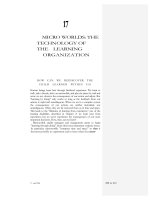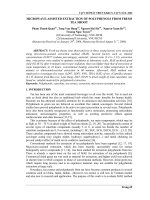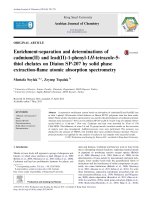Membrane protected micro solid phase extraction of pharmaceuticals from environmental water samples
Bạn đang xem bản rút gọn của tài liệu. Xem và tải ngay bản đầy đủ của tài liệu tại đây (7.02 MB, 90 trang )
MEMBRANE PROTECTED
MICRO-SOLID PHASE EXTRACTION
OF PHARMACEUTICALS
FROM ENVIRONMENTAL WATER SAMPLES
LIM TZE HAN
(BSc (Hons), MSc, NUS)
A THESIS SUBMITTED
FOR THE DEGREE OF DOCTOR OF PHILOSOPHY
NUS GRADUATE SCHOOL FOR INTEGRATIVE
SCIENCES AND ENGINEERING
NATIONAL UNIVERSITY OF SINGAPORE
2013
!
Declaration
I hereby declare that the thesis is my original work and it
has been written by me in its entirety.
I have duly acknowledged all the sources of information
which have been used in the thesis.
This thesis has not been submitted for any degree in any
university previously.
LIM Tze Han
15
th
June 2013
!
ACKNOWLEDGEMENTS
Heartfelt thanks is extended to my supervisors; Prof LEE Hian Kee and Dr
HE Chaobin, and members of my thesis advisory committee; Prof Li Fong
Yau, Sam and Dr Li Jun for the patience, support and advice offered during
my candidature. Special thanks to Dr Liu Qiping for her patience in
instruction and assistance in the chromatography laboratory (Department of
Chemistry, NUS)
I am most grateful for the offer of a research scholarship by the NUS
Graduate School for Integrative Sciences and Engineering (NGS) and the
generous support extended by NGS and her staff members during my
candidature.
TABLE OF CONTENTS
List of Abbreviations/symbols
I
List of Tables
III
List of Figures
IV
Summary
CHAPTER 1
INTRODUCTION
1
1.1
Preface
2
1.2
Conventional methods of preparing environmental water samples for
5
PAI analysis
1.3
Membrane-protected microextraction
10
1.4
μ-SPE in perspective
11
1.5
Sorbent selection in μ-SPE: Literature review
16
1.6
Thesis scope and objective
19
References
21
CHAPTER 2
METHODOLOGY
25
2.1
Preface
26
2.2
Preparation of sorbents
31
2.3
Characterization of sorbents
37
2.3.1 Elemental analyses
37
2.3.2 TGA
37
2.3.3 EWC
38
2.4
Evaluation of μ-SPE performance (EF and Rr)
39
2.4.1 Evaluation of EF
39
2.4.2 Evaluation of Rr
40
References
40
CHAPTER 3
EXPERIMENTAL
42
3.1
Chemicals and materials
43
3.1.1 Analyte standards
43
3.1.2 Solvents and pH modifiers for chromatography
43
3.1.3 Membranes
43
3.1.4 Sorbents and reagents for their surface modification
44
3.2
Method development
44
3.2.1 Preparation of spiked water samples
44
3.2.2 Preparation of spiked environmental water samples
45
3.2.3 μ-SPE
45
3.2.4 Liquid chromatography (LC)
46
3.3
μ-SPE devices
46
3.3.1 Device preparation
46
3.3.2 Preparation of surface modified sorbents
47
3.3.2.1
Preparation of APS
47
3.3.2.2
Preparation of UPS
47
3.3.2.3
Preparation of ZIPS
47
3.3.3 Characterization of sorbents and sorbent-containing devices
48
3.3.3.1
N,S elemental analyses
48
3.3.3.2
TGA
48
3.3.3.3
Determination of EWC
48
References
49
CHAPTER 4
RESULTS AND DISCUSSION
50
4.1
Preparation of sorbents
51
4.1.1 Preparation of APS and UPS
51
4.1.2 Preparation of ZIPS
53
4.2
EWC
54
4.3
Comparison of sorbents
55
4.4
Suggested sorption of extracted analytes by UPS and ZIPS
57
4.5
Optimization studies for UPS-based μ-SPE
58
4.5.1 Sample pH
58
4.5.2 Desorption time
59
4.5.3 Volume of desorption solvent
60
4.5.4 Optimal EF and comparison with previously reported EF values
61
4.6
Optimization studies for UPS-based μ-SPE
63
4.6.1 Sample pH
63
4.6.2 Desorption time
64
4.6.3 Volume of desorption solvent
65
4.6.4 Optimized EF and comparison with previously reported EF values
65
4.7
Method performance
67
4.7.1 Limits of detection (LOD) and quantification (LOQ)
67
4.7.2 Relative recovery
70
References
70
CHAPTER 5
CONCLUDING REMARKS
72
CHAPTER 6
SUGGESTIONS FOR FUTURE WORK
74
References
76
APPENDIX
Publications
77
!
!
!
!
!
!
!
!
!
!
!
!
!
!
!
!
!
!
!
!
!
!
!
!
!
!
!
!
!
!
!
!
!
!
!
I!
LIST OF ABBREVIATIONS/SYMBOLS
Ami
Amitriptyline hydrochloride
AMP
Analytical measurement process
APS
1-aminopropyl grafted silica gel sorbents
APTES
3-aminopropyltriethoxysilane coupling reagent
C18-silica gel
Commercial n-octadecyl modified silica gel
Cbz
Carbamazepine
CE
Capillary electrophoresis
Dfn
Diclofenac
DVB
Divinylbenzene
EF
Enrichment factor
EWC
Equilibrium water content
HF-LPME
Hollow fiber assisted liquid phase microextraction
HILIC
Hydrophilic interaction liquid chromatography
HLB
Hydrophilic-lipophilic balance
LC
Liquid chromatography
LLE
Liquid-liquid extraction
LOD
Limit of detection
LOQ
Limit of quantification
muSPE
Micro solid phase extraction using mixed matrix membrane
μ-SPE
Membrane bag micro solid phase extraction
MPME
Membrane protected microextraction
MWCNT
Multi-walled carbon nanotube
NVP
N-vinylpyrrolidone
OCP
Organochlorine pesticide
OPP
Organophosphate pesticide
OPM
Oligomeric and polymeric materials
PAH
Polyaromatic hydrocarbon
PAI
Pharmaceutically active ingredient
PBDE
Polybrominated diphenyl ether
PCB
Polychlorinated biphenyl
POCIS
Polar organic chemical integrative sampler
!
II!
PS
1,3-Propane sultone
Rr
Relative recovery
RSD
Relative standard deviation
SBME
Solid bar microextraction
SPE
Solid phase extraction
SPME
Solid phase microextraction
TEA
Triethylamine
TGA
Thermogravimetric analysis
UPS
Ureido grafted silica gel sorbents
ZIPS
Zwitterion grafted silica gel sorbents
!
!
!
!
!
!
!
!
!
!
!
!
!
!
!
!
!
!
!
!
!
!
!
!
!
!
!
!
!
!
!
!
!
!
III!
LIST OF TABLES
Table No.
Caption
4-1
Comparison of EF data for UPS-based μ-SPE with SPME, and previously
reported static mode membrane microextraction methods
4-2
Comparison of EF data for ZIPS-based μ-SPE with SPME, and previously
reported static mode membrane microextraction methods
4-3
Method performance for UPS-based μ-SPE
4-4
Method performance for ZIPS-based μ-SPE
!
!
!
!
!
!
!
!
!
!
!
!
!
!
!
!
!
!
!
!
!
!
!
!
!
!
!
!
!
!
!
!
!
!
!
!
!
!
!
!
IV!
LIST OF FIGURES
CHAPTER 1
INTRODUCTION
Fig No.
Caption
1-1
Widely reported organic pollutants in the freshwater environment
1-2
Work-flow in typical sample preparation and its palcement in an
analytical measurement process
1-3
Molecular structures of divinylbenzene isomers (I and II) and
N-vinylpyrrolidone monomers (III)
1-4
Illustration of conventional membrane filtration modes
1-5
Schematic illustration of (a) dead-end filtration and (b) crossflow filtration
1-6
Illustration of a POCIS device
1-7
Loose, powdered sorbents enclosed within membrane pouches as μ-SPE
devices
1-8
Proposed schematic of a typical μ-SPE process
1-9
Pre-concentration of analytes during μ-SPE
1-10
μ-SPE of ketoprofen and ibuprofen with commercially available sorbents
as reported by Basheer et al
CHAPTER 2
Fig No.
Caption
2-1
Chemical structures of investigated analytes
2-2
Surface modified silica gel employed in this work
2-3
Illustration of the repellent properties of zwitterated silica surfaces towards
protein (P) sorption
2-4
Preparation of APS sorbents through reaction between silica gel and
3-aminopropyltriethoxysilane coupling reagent
2-5
Proposed schematic of UPS preparation
2-6
Grafting from reaction strategy for preparing ZIPS
CHAPTER 4
Fig No.
Caption
4-1
Thermogravimetric analysis of silica gel (Sil) and surface modified silica gel
sorbents: ODS, APS and UPS
4-2
Comparison of EWC for ZIPS, UPS, APS and ODS for μ-SPE of Ami, Cbz,
Ket and Dfn
4-3
EF for Ami, Cbz, Dfn and Ket during μ-SPE from their aqueous solutions
using surface modified silica gel sorbents
!
V!
4-4
Proposed hydrogen bond donation from amido hydrogens on UPS surfaces
and hydrogen bond acceptor motifs on Ami, Cbz, Ket and Dfn
4-5
Effect of sample pH on EF during UPS-based μ-SPE
4-6
Effect of desorption time on EF during UPS-based μ-SPE
4-7
Effect of pH on analyte EF during μ-SPE using ZIPS sorbents
4-8
Effect of desorption time on analyte EF during μ-SPE using ZIPS sorbents
4-9
Method calibration plot for UPS-based μ-SPE
4-10
Method calibration plot for ZIPS-based μ-SPE
!
!
!
!
!
!
!
!
!
!
!
!
!
!
Summary
SUMMARY
Membrane-assisted micro-solid phase extraction (μ-SPE) is a recently introduced sample preparation
technique that integrates microextraction paradigms and membrane microfiltration with solid phase
extraction. It involved no more than a two-step workflow and enabled concurrent analyte extraction,
sample clean up and enrichment. It is well suited for analyses of environmental water samples
μ-SPE of selected psycho-active pharmaceuticals and analgesics was examined to gain insights into
sorbent designs and selection criteria that could enhance key parameters of μ-SPE namely; enrichment
factors (EF) and relative recovery (Rr), beyond what can be achieved using octadecyl silica gel sorbents
(ODS). Accordingly, replacement of octadecyl brushes on ODS with strategically selected molecular
motifs was adopted in this work for μ-SPE of analytes such as the quaternary salt of Amitriptyline (Ami),
Carbamazepine (Cbz), Ketoprofen (Ket) and Diclofenac (Dfn).
This dissertation begins with a review of scientific literature detailing the development and recent
applications of μ-SPE (Chapter 1), followed by an overview of the rational behind the approach used to
achieve the thesis objectives (Chapter 2). The methods, including experimental techniques, materials
and chemicals are detailed in chapter 3.
In Chapter 4, it is demonstrated that higher EF during μ-SPE from spiked water samples, can be
achieved by replacing octadecyl brushes on silica gel sorbent surfaces with the polar motifs; -(CH
2
)
3
NH
2
(for APS), -(CH
2
)
3
NHC(O)NH
2
(for UPS) and -(CH
2
)
3
N
+
(CH
3
)
2
(CH
2
)
3
SO
3
-
(for ZIPS). This was ascribed
to increased interaction between the donor phase and acceptor phase, and to better-matched polarity
between sorbent surfaces and extracted analytes during μ-SPE.
Summary'
ZIPS sorbents are noted in this work, for its high Rr during μ-SPE unlike APS and UPS that were
accompanied by only moderate Rr. The recently reported, repellant nature of zwitterion decorated silica
surfaces towards random sorption of surface-active, oligomeric and polymeric species, was suggested
as a possible reason for the observed improvement in μ-SPE performance. It is conceivable, that humic
and fulvic acids which are also oligomeric, surface-active substances would compete less effectively with
analytes for such surfaces. This possibly resulted in ZIPS, being able to achieve both high EF and Rr
during μ-SPE. Such sorbents are therefore, promising platforms for assembling sorbents for solid phase
extractions of environmental water samples and may be explored further in future studies.
'
Chapter 1: Introduction
1"
CHAPTER 1: INTRODUCTION
Chapter 1: Introduction
2"
1.1 PREFACE
It is crucial that environmental freshwater sources such as lakes, rivers and groundwater be regularly
monitored [1-3] for the presence of pollutants, because they are sources of drinking water in many
countries and their integrity, is extremely important for the maintenance of environmental and public
health.
In recent years, this endeavor has become more challenging because the very same freshwater
sources, have increasingly replaced the open sea as receiving basins for effluent streams from municipal
wastewater treatment plants. This is the ironical result of contemporary freshwater conservation and
recycling efforts [4, 5], and has resulted in the contamination of freshwater sources with organic
compounds (Fig 1-1) that are poorly removed at wastewater treatment plants [1,6-9]. A number of these
compounds have been detected at concentration levels on the order of μg/L in several environmental
water samples. Although they are unlikely to present risks of acute toxicity with some exceptions, the
possibility of chronic toxicity arising from prolonged exposure remains a cause of concern, resulting in
their classification as emerging contaminants [10, 11].
Several of the compounds listed in Fig 1-1 have non-coincidentally, been identified as contemporary
targets for research efforts in environmental analytical chemistry [12]. Among these, commonly
prescribed pharmaceutically active ingredients (PAI) have attracted much attention because of their
inherently bioactive nature, and non-feasibility of usage regulation due to their benefits to human health
[5].
Chapter 1: Introduction
3"
Fig 1-1. Widely reported organic pollutants in the freshwater environments (Compiled from refs [1, 6-9])
Chapter 1: Introduction
4"
PAI are typically organic molecules of medium to high polarity and of low volatility [4, 5]. Apart from
accounting for their poor removals at wastewater treatment plants, this particular physicochemical
characteristic indicated that analyses of environmental water samples for the presence such compounds
is not straightforward especially where sample preparation is concerned (figure 1-2, [13]).
Fig 1-2. Work-flow in typical sample preparation and its placement in an analytical
measurement process.
Chapter 1: Introduction
5"
Direct extraction of PAI, most of which are polar or hydrophilic from their aqueous solutions can be highly
challenging due to the lack of suitable extractants that is complicated further, by the presence of matrix
components such as humic and fulvic acids [14,15]. Also, extensive pre-concentration will be required
because of their low concentration in such matrices. Further more, unless extracted analytes are
converted into volatile chemical derivatives
1
[16], the low-volatility of these compounds meant that final
analyses will involve LC or CE systems, thereby requiring samples to be constituted in solvents
compatible with these analytical systems prior to actual analysis.
1.2 CONVENTIONAL METHODS OF PREPARING ENVIRONMENTAL WATER SAMPLES FOR PAI
ANALYSIS
Solid phase extraction (SPE) using Oasis HLB® sorbents remains the conventional strategy of preparing
environmental water samples for PAI analyses [1, 8, 11, 17, 18] as attested to by the number of related
publications [19].
In SPE, sorbent beds are fabricated and immobilized within syringe barrels, or in the form of disk
catridges [20] by pressurized packing of porous, powdered sorbents using proprietary packing and
compression technologies [21]. PAI were extracted directly onto sorbent pores as water samples were
drawn through the sorbent bed by vacuum suction. The extracted PAI were generally eluted from the
sorbent bed using solvents e.g. methanol, that are volatile, water miscible and of high eulotropic
strength. The resulting eluent was pre-concentrated by evaporating to dryness with a dry N
2
gas stream,
followed by re-constitution in a minimal volume of solvent. The resulting concentrate may thence be
introduced into an LC or CE system for measurement.
""""""""""""""""""""""""""""""""""""""""""""""""""""""""
1
Although this last requirement can be circumvented with chemical derivatization, the extra step incurred coupled with its
complexity meant that this is a measure that most analysts tended to avoid [16]
"
Chapter 1: Introduction
6"
The requisite Oasis HLB sorbents [22] consisted of macro-recticular co-polymers of divinylbenzene
(DVB) and N-vinylpyrrolidone (NVP) (figure 1-3). Judicious control of DVB and NVP proportions during
preparation, enabled these sorbents to possess interfacial energies that are closely matched with those
of PAI and other polar analytes, whilst remaining resistant to flooding but yet possessing adequate
‘wettability’ [23] for effective extraction to occur. Hence, these polymeric sorbents may be loosely
regarded as tailored extractants for SPE of polar compounds from aqueous matrices.
SPE can be fully automated and even integrated with LC systems that are hyphenated with mass
spectrometer detectors (LC-MS) including triple quadrupole mass analyzers. These fully integrated
systems are definitely capable of handling the commonly encountered PAI concentrations in
environmental water samples that are in the order of ng/L to μg/L levels [11, 24-27].
However, the use of these fully integrated systems incurs additional costs that are definitely not trivial.
Also, the technique as a whole had a few inherent drawbacks. Most notably, for extraction from
environmental water samples, clogging of sorbent bed by particulate matter can adversely impact
Fig 1-3. Molecular structures of divinylbenzene isomers (I and II) and N-
vinylpyrrolidone monomers (III)
Chapter 1: Introduction
7"
technique precision because of interrupted sample flow under these circumstances. The development of
porous membrane protected SPE disks addressed this particular challenge by providing concurrent
microfiltration of samples during extraction. This protected the sorbent bed to a certain extent by
excluding particulates with dimensions above 0.1μm (figure 1-4, [28]) from the sorbents.
Also, disk based SPE involved cross-flow filtration mechanisms (figure 1-5, [29]) that unlike the dead-end
filtration mechanisms of the more widely used syringe barrel SPE, was less likely to generate
concentration polarization at membrane surfaces [29, 30].
Fig 1-4. Illustration of conventional membrane filtration modes [28]
> 0.1μm
> 0.01μm
> 0.001μm
> 0.0001μm
Chapter 1: Introduction
8"
Membrane protected SPE disks in the form of Polar Organic Chemical Integrative Sampler (POCIS),
whereby selected sorbents were sandwiched between polyethersulfone microfiltration membrane sheets
(figure 1-6, Huckins et al [31, 32]), have been highly popular for passive sampling cum extraction of polar
organic contaminants from environmental water sample.
Fig 1-5. Schematic illustration of (a) dead-end filtration and (b) crossflow filtration.
Reproduced with permission from [29]
Chapter 1: Introduction
9"
POCIS devices that are specific for PAI extraction employed Oasis HLB™ as sorbents. Other
developments included devices such as Chemcatcher [33] and Empore disk [34] that employed C18-
silica gel sorbents. Despite being lipophilic sorbents, C18-silica gel has been reported to be capable of
extracting polar organic compounds through mixed mode interactions [35]. Nevertheless, they differed
from POCIS mainly in terms of device design and sorbent selection rather than operational principle.
However, their use in conjunction with grab sampling remains limited compared to conventional syringe
barrel SPE. This is because the latter remains more amenable to high-throughput formats. Also, because
of the substantial amounts of sorbents involved, membrane protected SPE disks were not absolved from
other notable drawbacks of SPE such as its multi-step workflow and high costs of disposable sorbent
materials [36]. The need for washing of sorbent beds prior to elution with aqueous organic solvents
meant that solvent usage remained significant [37].
Fig 1-6. Schematic illustration of a POCIS device. Reproduced with permission
from [32]
Chapter 1: Introduction
10"
3 MEMBRANE PROTECTED MICROEXTRACTION
The introduction of microextraction paradigms in the 1990s [38-41], addressed the need for
miniaturization and also the need for minimizing solvent usage in conventional analytical extraction
procedures such as SPE and classical liquid liquid extraction (LLE).
Microextraction techniques are characterized by the extraction of analytes from a given donor phase, into
a minuscule volume of a selected acceptor phase. This enabled concurrent occurrence of analyte
extraction and pre-concentration [42]. Incorporating a microfiltration membrane at the interface of both
phases, enabled sample clean up to occur concurrently with microextraction. Therefore, single-step
sample procedures that integrated the once discrete component steps of clean-up, extraction and pre-
concentration could be realized with these membrane-protected microextraction (MPME) techniques
[43].
The incorporation of MPME paradigms into classical LLE have been well-established, culminating in the
development of highly popular techniques such as hollow fiber membrane supported liquid phase
microextraction (HF-LPME) and other related developments [40] including semi-automated formats [39,
45-47] that have been employed for PAI extractions [40, 46-48] from various aqueous matrices.
However, analogous developments in SPE have been relatively slow despite the advantages offered by
SPE for PAI extraction that included the possibility of direct extraction, infinite partitioning of analytes
towards the acceptor phase and the potential to present interfacial forces that are closely matched with
those of PAI analytes.
SPE and related techniques that have incorporated MPME paradigms are generally referred to as
membrane protected micro solid phase extraction because analytes extracted by the acceptor phase,
Chapter 1: Introduction
11"
have to be eluted with a small volume of organic solvent e.g. methanol to give a concentrated solution
before being introduced into the selected analytical system [49]. These techniques are very useful for
thermally labile and non-volatile compounds that in the absence of chemical derivatization, mandated
analysis by liquid chromatography (LC) or capillary electrophoresis (CE). They are exemplified by the
techniques of mixed matrix (hollow-fiber) membrane micro-solid phase extraction pioneered by Mitra’s
group [50-60], and microporous membrane-protected micro solid phase extraction (μ-SPE) pioneered by
Lee’s group [61-66, 71-73, 75] and other similar techniques.
1.4 μ-SPE IN PERSPECTIVE
For analyzing environmental water samples for the presence of PAI and several other emerging
contaminants, the use of μ-SPE is merited by its suitability in analytical measurement processes
involving off-line detection, the ease of multiple loci deployment within a given sampling zone, and the
possibility of single usage devices if desired.
μ-SPE makes use of edge-sealed envelopes (typical dimensions: 1cm by 0.8cm, Fig 1-7), fabricated in-
house from commercially available flat sheet membranes made of microporous polypropylene, as
devices for extraction
Chapter 1: Introduction
12"
A typical procedure for preparing devices involved cutting a piece of commercial microporous,
polypropylene sheet membrane into rectangular sheets with typical dimensions of c.a. 2cm by 0.8cm.
The longer edge was folded over to a width of 1cm. The edge of the fold-over flap was heat-sealed with
an electrical sealer. One of the two remaining open ends was similarly heat-sealed to create an
envelope. A given mass of selected sorbent was packed into each envelope with a micro-spatula via the
last open end that was then heat-sealed to afford a μ-SPE device.
Extraction generally occurred when individual devices were allowed to tumble freely within sample
solutions (Fig 1-8), assisted by magnetic stirring.
Fig 1-7. Loose, powdered sorbents enclosed within membrane pouches as μ-SPE
devices.









